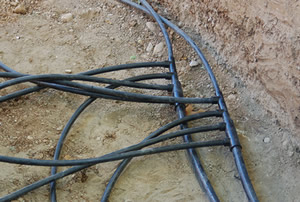- 23 reads

On February 17, 2009, President Barack Obama signed the American Recovery and Reinvestment Act (ARRA) of 2009. All told, the bill calls for the spending of $787 billion dollars over the next number of years on the expansion of unemployment benefits and other social welfare programs, and domestic spending on health care, education, and infrastructure, which includes the entire energy sector.
The bill sets aside $5 billion for the weatherizing of modest-income homes, but you have to know how to get that money. A lot of that money will be distributed as Tax Credits on the installation of new, more energy-efficient products that will help wean the United States off of its dependence on fossil fuels. Listed below are the details on Home Improvement.
The ARRA allots $4.3 billion for improving the energy efficiency of homes in 2009 and 2010. Homeowners can recoup up to 30% of the cost of one specific project up to $1,500, which also includes installation costs for heating and cooling equipment. The ARRA triples the amount available for a tax credit from $500 to $1,500. It also removes the cap on geothermal heat pumps and solar energy through 2016.
To be eligible the tax credit for improving energy-efficiency of a home, you have to be purchasing and installing products at very specific standards. There are two standards for which home improvements can qualify for the tax credit. The first is for items placed in service (installed and running) between January 1, 2009 and February 17, 2009. The terms of the tax credit are less clear for this time period, however the Internal Revenue Service will likely clarify these terms in guidance documents, which are expected to be released later this year.
The second standard, which is documented below, applies to products placed in service between February 18, 2009 and December 31, 2010. Listed below are the specifics for each HVAC upgrade, and while they share similarities, each product demands different levels of efficiency.
Central Air Conditioning (CAC)
There are two systems that are covered by a tax rebate that can deliver Central Air Conditioning to the home. There are Split Systems, and Package Systems. For Split Systems, the Energy Efficiency Ratio (EER) must be at or above 13, while the Seasonal Energy Efficiency Ratio (SEER) has to be at or above 16.
For Package Systems, the EER needs to be at or above 12, while the SEER must not go below 14.
Air Source Heat Pumps (ASHP)
Like the Central Air Conditioner, the ASHP has the same two systems covered by a tax credit. For Split Systems, the Heating Seasonal Performance Factor (HSPF) needs to be at or above 8.5. It also must have an EER of 12.5 or above, and a SEER of 15 or higher.
For Package Systems, the HSPF must be above 8, while the EER and the SEER have to be at or above 12 and 14, respectively.
Note: Energy Star® approved CAC and ASHP are as follows; Split Systems: HSPF >= 8.2; EER >= 12; SEER >= 14.5; and Package Systems: HSPF >= 8; EER >= 11; SEER >= 14. So you can’t miss out on the tax credit if you stick with Energy Star® for these products.
Natural Gas or Propane
The Natural Gas or Propane fueled heater must have an Annual Fuel Utilization Efficiency (AFUE) of more than 95 to qualify for the tax credit. On this item, not all Energy Star® products will qualify. For a list of qualified products take a look at what the Gas Appliance Manufacturing Association has to say.
Oil Furnace or Gas, Propane, or Oil Hot Water Boiler
All of these installations must have an Annual Fuel Utilization Efficiency (AFUE) of more than 90 to qualify for the tax credit. On this item, like Natural Gas or Propane, not all Energy Star® products will qualify. For a list of qualified products take a look at what the Gas Appliance Manufacturing Association has to say.
Note: The Energy Star® specifications are as follows: Gas Furnaces: AFUE >= 90; Oil Furnaces: AFUE >= 85; Boilers: AFUE >= 85. This does not mean that they all qualify.
Advanced Main Air Circulating Fan
This addition must not constitute more than 2% of the furnace’s total energy use. You can see a partial list of qualifying products here.
Geothermal Heat Pump
The requirements for a Geothermal Heat Pump tax credit are the same that Energy Star® holds. For a Closed Loop system, the EER must be at or above 14.1. It must also have a Coefficient of Performance (COP) of 3.3 or higher. For Open Loop systems, the EER must be at or below 16.2 with a COP of 3.6 or higher. And lastly, for a Direct Expansion system, the EER must be 15 or higher, and the COP must be at or above 3.5.
All Energy Star® labeled geothermal heat pumps qualify for the credit. However, they must be placed in service (installed and running) between January 1, 2009 and December 31, 2016. This product is one of very few whose cap has been lifted all together. It is not bound by the $1,500 cap, and the homeowner installing this heat pump can recoup the entire 30% of the total costs as a tax credit. You must use IRS form 5695.
GREENandSAVE.com is a free resource for anyone that wants to save energy, money, and the environment. The articles, product reviews, online tools, and return on investment calculations are researched from a diverse range of public and private sector sources. Overall, the company is passionate about saving money as well as creating healthy homes, offices, and lifestyles.
For ways to improve your home without Government Assistance, take a look at GREENandSAVE.com for your next Green Home Remodeling project. Or, for more information on one major project that can save you money on utility bills, take a look at the GREENandSAVE article on Hot Water Heater Blankets.

